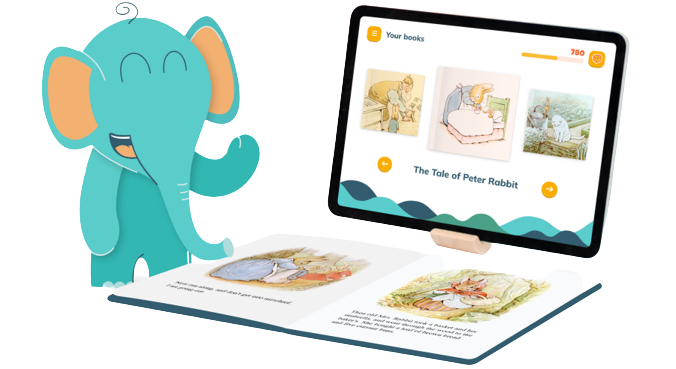Assessing Children's Literacy Rates in America: A 2023 Overview
Let’s dive into a topic close to every parent’s heart: children’s literacy. We all know that reading is a key to success, and it’s never too early to start nurturing this vital skill.

Let’s dive into a topic close to every parent’s heart: children’s literacy. We all know that reading is a key to success, and it’s never too early to start nurturing this vital skill.

Despite the importance of reading success for young learners, literacy rates in America have long been a subject of concern. You’ve probably seen numerous articles sounding the alarm about dropping literacy rates in the US due to concerns about how we teach reading, and the impacts of COVID. In this post, we will discuss the current state of children's literacy rates in America and what you need to know as a caregiver to help support your child’s literacy development.
While progress has been made over the years, when it comes to literacy rates in the US, challenges persist. According to the National Center for Education Statistics (NCES), recent data suggests that a significant percentage of American children still struggle to achieve proficient reading levels. This gap in literacy achievement can have far-reaching consequences, impacting academic performance, employability, and an overall quality of life. It's crucial to acknowledge that literacy isn't just about decoding words; it's also about comprehending and engaging with complex texts, fostering critical thinking, and nurturing a lifelong love for learning.
Instructional methods significantly influence literacy outcomes. When educational approaches deviate from evidence-based practices that prioritize phonemic awareness, phonics, vocabulary development, reading fluency, and comprehension strategies, students can experience reading difficulties. Such methods might not equip them with the foundational skills needed to navigate a diverse range of texts effectively. Additionally, the COVID-19 pandemic has introduced new challenges, further exacerbating existing disparities in literacy rates. School closures, remote learning, and disruptions to classroom routines have potentially disrupted children's reading progress. Limited access to educational resources and technology could have hindered reading development for those without equitable access.
Addressing these challenges requires a multi-faceted approach. It involves promoting evidence-based instructional methods that empower children to become confident, competent readers. It also entails recognizing the diverse needs of learners and ensuring access to resources that support literacy growth. By addressing these issues head-on, we can pave the way for improved literacy rates, setting our children on a path toward success and a brighter future.

An essential component of literacy development is phonics—the relationship between sounds and letters—which forms the foundation of reading and spelling skills. Research consistently highlights the significance of phonics instruction in improving children's literacy. The National Reading Panel, an authoritative source on literacy research, emphasizes the benefits of systematic phonics instruction in helping children decode and recognize words accurately. Phonics instruction enables children to understand the connections between letters and sounds, equipping them with essential skills to decode unfamiliar words and enhance reading fluency.
In the spirit of inclusivity, the American Library Association (ALA) has been working hard to make sure all kids find their place in the world of literature. With initiatives like "We Need Diverse Books," the ALA is boosting the availability of culturally relevant books, ensuring every child finds stories that resonate with their experiences. Diversity and representation in children’s books matter, as children are more likely to be successful and engaged with content that is reflective of their lives and experiences.

Technology is shaping our world, and it's making its mark on literacy too. The Joan Ganz Cooney Center at Sesame Workshop delves into the positive impact of educational technology on children's literacy skills. Digital tools and platforms, like e-books and interactive apps, are engaging young readers and boosting their comprehension. With recent advances in technology, there is a real opportunity for equitable access to best practices in education, and the option to have content tailored to individual learners. Despite the immense potential, it is important for ed-tech leaders to ensure safety and maintain a high quality bar as innovation occurs. We take this responsibility seriously at Ello, and we are building hand in hand with eduction leaders and teachers to ensure safe and effective literacy instruction and practice.
While progress is evident, we can't ignore the challenges. Socio-economic disparities and limited resources continue to affect access to quality education and reading materials. The Campaign for Grade-Level Reading highlights the achievement gap as a significant hurdle. But remember, collaborative efforts and continued focus on accessible resources can pave the way for a brighter future.
Now, let's talk about you – the real MVPs in your child's literacy journey! Research by the National Institute for Literacy underscores the immense impact of parental involvement. By reading aloud, creating a book-friendly environment at home, and sharing reading experiences, you're setting your child up for a lifelong love of reading and learning.
In this ever-changing world, literacy remains a cornerstone for success. We've made strides, but there's work to be done. By championing accessible resources, encouraging inclusivity, and nurturing a reading-friendly environment, we can equip our children with the tools they need to thrive. So, fellow parents, let's keep the pages turning, the stories flowing, and the magic of reading alive!
